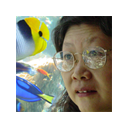Download file
With Chaplain Medeiros' and Elaine Blitman's (class artist-in-residence) guidance the students contributed their art work and words in chapel. The Adobe Photoshop Elements fish prints were presented before, during and after the service in a Powerpoint loop, illustrating the theme of rainbows. The students wrote the explanation of gyotaku history and the process of their work.
Appropriate public viewing, as in Chapel of a student's visual art is important for the self-efficacy of the student as a cultural member. [more later]
We had a brief acknowledgment of the student's work and review session after chapel with Chaplain Medeiros, and Josh explaining the production process. Organizing work and storing them in the proper format were problem solving challenges that were made simple by the facile and experienced student from San Diego, Josh. I could see that Powerpoint with this student's mentorship of other less experienced students will be a good way to share our work in the last week of summer school's family open house. A continuous loop of student work and narration works well for an open house when family members may not make it to class in time for their child's presentation; or emailed or stored on disk. In the past digital documentation worked well for an animation class, as we were able to show the students' problem solving process as well as the final very short and time intensive animation.
I think I will always remember the frustration of being stuck in gridlock on a crowded bus in Boston trying to get to my son's class' robotics presentation at the Science Museum. My son's condern, disappointment and frantic cell phone calls to me as to where I was are memories that remind me how wonderful (and usually increasingly easy) digital documentation is. Problem solving documentation is a valuable part of learning for the teacher and student. Ironically, we were in Boston because I was presenting my visual epistemology research of 4.5 yr old triplet students in a "Making Learning Visible" documentation workshop at Harvard.
Digital recording allows for distributed cognition and reflection. When I am exhausted from the day's or week's events, usually from the affective part of teaching, it is difficult to review what happened. I have always been very thankful for the "self-teachable" moments when I'm able to look and hear with a new perspective at digital documentation. Among my favorite documentations that have helped me to be a better observer and communicator with parents as to their child's problem solving ability: My discussion question: "What can't they [schools] test for?" Student's animated answer: "Love . . . [and metaphorical explanation as to experiencing a kinetic sculpture.]" A student mistaking the word "florist" for "forest". My awe that I totally did not recognize the misunderstanding until I viewed the video. A unsettling experience was individually digitally recording on the iBook my husband's, son's and my memories of the morning of 9/11, and the day of 9/11, looking at my son's visual journal photographed and written 6 months before from NYC and the Trade Towers. There is a photo of my son emailing his 4th grade class from my teacher cousin's classroom a few blocks north of the Towers. He survived, but his brother who worked in the Towers did not. The digital record for the three of us is an important way to allow us to grieve as well as celebrate and through distributed cognition, try to identify loss.
Digital documentation is difficult to organize and to make meaningful. It took me 10 years to revise a recording method for a digital portfolio of authentic assessment of student work.











 Melissa Kim Mosher's Summer Lab School Blog
Melissa Kim Mosher's Summer Lab School Blog
Recent Comments
Carole Iacovelli says: I am fascinated by both Melissa and... [more]
Don Zundel says: Interesting learning outcome, where... [more]
Don Zundel says: Hello Melissa, My name is Don Zunde... [more]
Jerome Burg says: WOW! Those are beautiful!! I want ... [more]